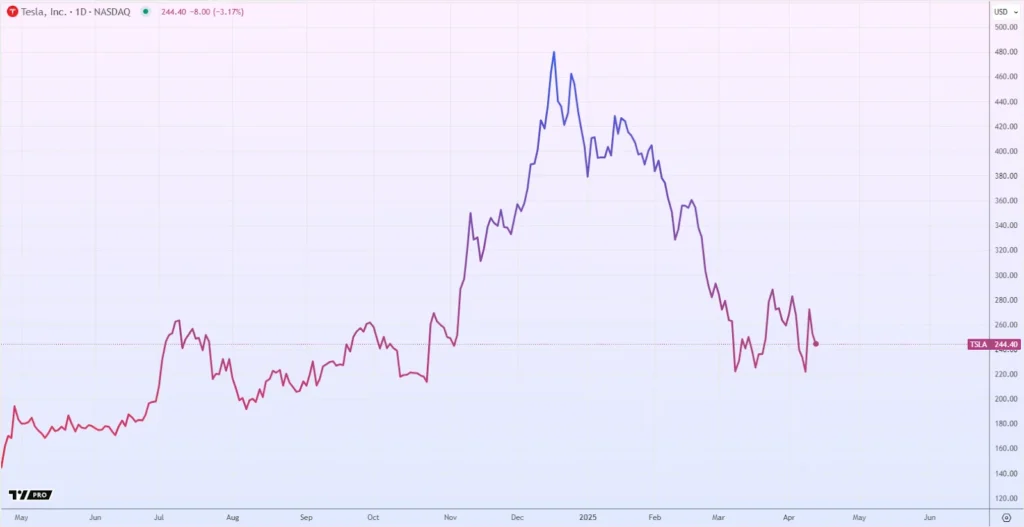Tesla faces serious challenges in key markets like China and the United States. The company has stopped accepting orders from China for its premium Model S and X vehicles. In the United States, Tesla’s electric cars have flooded the secondary market, putting pressure on prices.
The situation in China is particularly revealing. The Model S and Model X are manufactured exclusively in the United States, meaning their shipments to China are subject to customs duties. Amid fierce competition from local automakers (BYD, NIO, Xpeng) and a general decline in prices for electric vehicles in China, imported Teslas have become economically ineffective.
These issues come as Tesla stock has lost almost 50% since peaking in December 2024. Market participants remain uncertain about the company’s next steps. We’ve seen a massive selloff of Tesla shares over the past four months, mostly due to long-term investors’ concerns. However, smart traders using automated trading systems have been less affected by such market disruptions.
The company has no plans to discontinue Models S and X. A long time has passed since the previous restyling in 2022, so the models may be refurbished by the end of this year. Interestingly, on March 31, the company stopped accepting orders for customized versions of the S and X in Japan.
Globally, Tesla’s older models are not in high demand, accounting for less than 4% of the company’s total production. Most sales come from the Model 3 and Model Y, which are assembled at Tesla’s gigafactory in Shanghai and, therefore, are a subject to Trump-imposed tariffs.
In the meantime, there’s been a surge in Tesla’s secondary market supply in the United States. Owners are actively selling their electric vehicles, which creates additional pressure on prices. Several factors contribute to this trend:
- Lower cost of new Teslas (due to price wars and government incentives);
- Expiration of preferential programs (e.g., tax deductions);
- Rising interest rates, making auto loans less affordable.
In March, a wave of Tesla vehicles flooded the American used car market. More than 13,000 Teslas listed for sale appeared on specialized websites, setting an absolute record.
As a result, the market value of used Tesla cars continues to fall, and the company is forced to balance between stimulating new sales, maintaining the residual value of its vehicles, and regaining investor confidence, which has begun to waver.
Another problem Tesla faces is the delay and rising prices for the eagerly anticipated Cybertruck. The company has recently opened orders for the rear-wheel drive version, but its cost was significantly higher than initially promised. In 2019, Elon Musk stated that the base version of the Cybertruck would cost $39,990. By 2023, it became clear that the actual price would be at least $60,990. The most affordable rear-wheel version now starts at $69,990.
At the same time, the configuration has become more modest:
- The power reserve has been reduced from the claimed 250+ miles to 250 miles (approximately 400 km).
- Acceleration to 60 mph takes 6.5 seconds (compared to 6.3 for competitors like the Ford F-150 Lightning).
- All-wheel drive versions start at $69,990.
It is also worth noting that Tesla recently began offering the Cybertruck in Saudi Arabia. Previously, the cars were officially available only in North America, including Mexico and Canada.
Tesla remains the leader in the EV market, but its list of challenges is growing.
In China, it loses out to domestic brands and curtails sales of expensive models. In the US, an overabundance of used Teslas results is driving down prices. The Cybertruck has disappointed many fans — it was too costly and not as slick as promised.
If Tesla does not find a way to reduce prices without compromising profits, its position could weaken. For now, the company is holding on to the Model 3 and Model Y.
Tesla remains strong, but its “golden age” may be ending if it does not adapt to the new market conditions.







